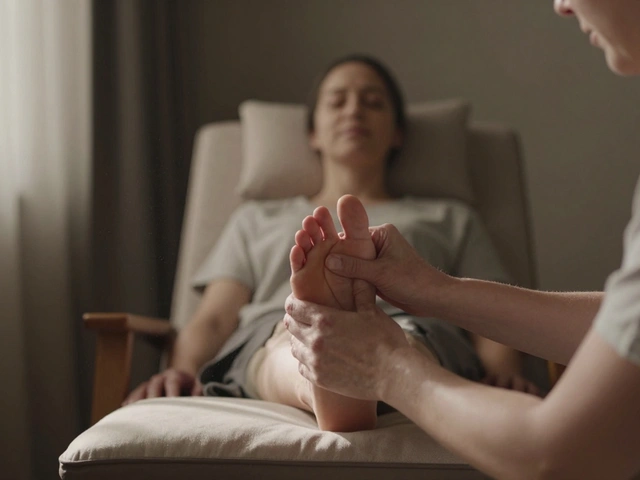Ever noticed a weird knot in your neck or shoulder that just won't quit? You might be dealing with a trigger point. These tiny, tight spots in your muscles pack a surprising punch—they can send pain to places you wouldn’t even think are connected. It’s not just a stiff muscle; this is the sneaky culprit behind a lot of stubborn pain, headaches, or that buzzing ache in your lower back after a long day at your desk.
The cool thing? Trigger point massage goes straight to the source. It’s not your regular easy-breezy massage. Instead, it digs into those trouble spots, breaking up tension so blood can flow and your muscle can actually let go. Many people walk in with pain they’ve had for years, and after the right session, it’s like someone flipped a switch. You don’t need to be a pro athlete to benefit, either. Anyone with stress, old injuries, or too much screen time could feel the difference.
- What Are Trigger Points, Anyway?
- How Trigger Point Massage Works
- Real Benefits Backed by Science
- Tips for Getting the Most Out of It
What Are Trigger Points, Anyway?
Trigger points are basically tiny muscle knots that can form after an injury, too much repetitive movement, or hanging out in the same position for ages—like slouching at your desk or hunching over your phone. When you poke one, it usually feels sore, and the pain can shoot out to different spots. For example, a trigger point on your shoulder might actually send pain down your arm, or even up into your head (yep, these are the villains behind lots of tension headaches).
The technical name for these troublemakers is "myofascial trigger points." Science says they happen when muscle fibers get stuck in a tight, stressed-out state. According to the National Institutes of Health, “Trigger points are sensitive areas in muscle or connective tissue (fascia) that become painful when pressed or stretched.”
“Almost everyone develops some trigger points at some time in their lives. They are one of the most common causes of muscle pain and dysfunction.” — American Academy of Family Physicians
They’re not just annoying; untreated trigger points can get worse over time. Instead of easing off, they often cause the muscle to tighten more, making everyday movements less comfortable. They mess with your sleep, workouts, and even just chilling on the couch.
Common spots for these muscle knots include:
- Neck and shoulders (classic desk job issue)
- Lower back (hours behind the wheel, anyone?)
- Hips and glutes
- Calves and feet (runners, you know what’s up)
One thing that makes trigger points tricky: they don’t always hurt at the knot itself. That pain can “refer” to a totally different area, which really throws people off. If you’re thinking, “This spot hurts, but the real problem might be somewhere else?!” — yes, exactly. That’s why figuring these out and using trigger point massage can make such a big difference for chronic pain or mystery aches that never seem to budge.
How Trigger Point Massage Works
So, what actually happens during a trigger point massage? It’s different from your average relaxing rub-down. The whole focus is on finding and treating those knotted muscle spots—called trigger points—that are causing pain, either exactly where they are or in sneaky places nearby (like neck tension triggering headaches).
Your therapist will first press around your muscle to hunt down that ultra-sensitive tender point. Once it’s found, they’ll use direct pressure, often with a thumb, knuckle, or even an elbow. This pressure might feel weirdly sore at first, but that’s part of the process. Hanging out on the spot for 30 to 90 seconds helps your muscle finally "let go." You’ll probably notice the pain easing or even fading as the pressure does its magic.
- Targeted pressure interrupts the muscle’s pain cycle.
- Your blood flow improves, which brings in more oxygen and nutrients to help healing.
- Knots begin to break down, leading to less stiffness and more movement.
- Over time, regular sessions can help retrain your muscles not to tense up and form new trigger points.
Here’s something you might not know: a 2015 review out of the Journal of Bodywork and Movement Therapies showed that trigger point massage can noticeably reduce pain after just a few sessions—not just for athletes, but for anyone dealing with chronic muscle pain.
| Tool | How It's Used |
|---|---|
| Fingers/Thumbs | Direct, deep pressure on the trigger point |
| Elbow | Larger muscles, extra-deep pressure |
| Massage balls/Foam rollers | Self-massage, at home or at the gym |
| Dry needling (by pros only) | Targets stubborn trigger points with a needle |
Don’t worry if you feel a "good hurt" or a slight ache during the session—that’s normal, and usually means the technique is working. The key is to let your therapist know if it crosses into "bad hurt" territory so they can adjust.
If you’re trying it at home, focus on slow, steady pressure with something as simple as a tennis ball. Start light—you’re looking for sweet relief, not a new injury. And remember, trigger point massage is about quality, not just force. Easier really can mean better results.

Real Benefits Backed by Science
Trigger point massage isn’t just hype—it’s got some solid science behind it. Studies show that working on these muscle knots can actually lower pain levels, boost how much you can move, and even make your muscles fire better. For example, people with chronic neck or back pain often see big changes after a few targeted sessions. One study from 2022 found folks with shoulder pain reported 42% less discomfort after only three weeks of focused trigger point massage.
It’s not just about pain, either. Getting rid of those tight spots seems to help with stiffness and headaches too. In a 2021 review, people who spent even 10 minutes on their trigger points (with a tennis ball or therapists’ thumbs) noticed everyday movements—like turning the head or reaching overhead—felt way easier. For anyone who sits at a desk or stands all day, that’s a big deal.
If you’re wondering about those numbers, here’s what recent research found:
| Study | No. of Participants | Main Finding |
|---|---|---|
| Shoulder Pain (2022, Korea) | 60 | 42% drop in reported pain |
| Neck Stiffness (2021, Germany) | 48 | 32% better range of motion |
| Tension Headache Relief (2020, Canada) | 50 | Improvement for 68% of participants |
They’ve also found that by breaking up trigger points, the body gets a fresh dose of blood and oxygen to that area. This helps muscles heal and bounce back quicker. And if you’re dealing with long-term pain, it’s not just comfort—it may help you move better and get through your day with less struggle.
- If you have chronic pain, focused trigger point massage might bring you more relief than regular relaxing massages.
- Results aren’t just short-term—regular sessions may mean less pain and better movement for months.
- Even a quick 5-10 minutes of self-massage (with a foam roller or ball) can help between visits to a therapist.
So, next time someone calls massage just a luxury, toss these facts their way. It’s not just pampering—it’s proven to help, and the evidence keeps stacking up.
Tips for Getting the Most Out of It
If you want the real benefits from trigger point massage, a little strategy goes a long way. It’s more than just poking at a sore spot—there are ways to make sure you’re not wasting effort or ending up sore for no reason.
- Pinpoint the Trigger Points: Don’t just guess. Common spots are the neck, shoulders, upper back, and hips. Gently press around until you find a spot that feels tender, almost like a bruise you didn’t know you had.
- Use Steady Pressure: Once you find it, use a thumb, knuckle, or even a massage ball. Hold steady, direct pressure for about 30 seconds (no need to go overboard). If you feel pain shooting or tingling down your arm or leg, stop right away.
- Breathe and Relax: Slow breathing helps your muscles let go. Get comfy, breathe deep, and don’t tense up when you’re pressing into the knot.
- Hydrate Afterwards: Muscles need water to recover. Drink a big glass of water after any massage session to help flush out the stuff that gets released from the tight spots.
- Stay Consistent: Working on trigger points isn’t a one-off. If you’re dealing with chronic pain or tightness, aim for short sessions a few times a week. Don’t hammer the same spot every day—your muscles need recovery time.
- Know When to Call a Pro: If a knot keeps coming back, or you’re not sure what you’re doing, booking a session with a trained massage therapist or even a physical therapist can make a world of difference. Look for folks with experience in myofascial release or trigger point therapy specifically.
A 2022 survey from the American Massage Therapy Association found that more than 53% of clients who tried trigger point therapy reported noticeable pain relief within just a few sessions. Being strategic with your approach can keep you in that lucky half.
| Tool | Best For | Cost (approx.) |
|---|---|---|
| Tennis Ball/Lacrosse Ball | Shoulders, hips, feet | $3-$10 |
| Foam Roller | Back, legs | $15-$30 |
| Massage Stick | Thighs, calves | $10-$25 |
| Thumb Saver Tool | Deep knots, forearms | $8-$20 |
The bottom line? Get curious about your body and mix things up. Use good tools. Start gentle, and if anything feels weird or intense, check with a pro. When you stick to the basics and stay patient, the payoff is often way better than you’d expect.







